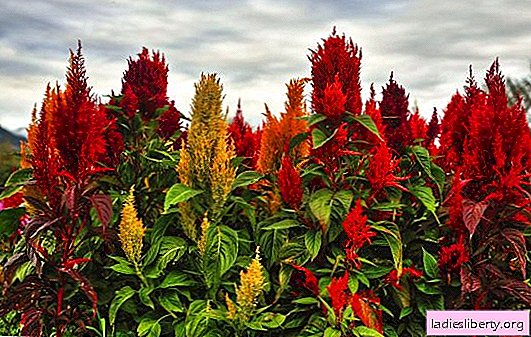
Amaranth or shiritsa in our climate is grown as an annual, the plant is not able to tolerate harsh winters. There is nothing difficult in planting seeds, but you need to know some features.
Sowing and growing amaranth from seeds
Amaranth seeds are very small, they can be sown for seedlings or immediately into the ground. In favorable weather, the seeds germinate quickly, seedlings develop well.
How to sow amaranth seeds in the soil
At the end of April, prepare the garden bed, dig it in advance, level it and clean it of weeds. Under digging, you can make mineral fertilizers, but you need to know the measure. The plant turns nitrogen fertilizers into nitrates that are hazardous to health.

Make shallow grooves, approximately 1.5 cm, and evenly distribute the seeds. For convenience, they are mixed with sand or sawdust. Lightly touch the ground. Shoots will appear on day 10, as soon as they get stronger, thin out the seedlings. There should be at least 10 cm between plants.
Seedlings are fed when they reach a height of 20 cm. Mineral complexes are used, but the dosage is reduced by 2 times.
Advice! No need to postpone sowing seeds in May, as weeds will displace the plant.
Growing seedlings of amaranth (instructions with photos)
To grow seedlings begin not earlier than March. Use cups, plastic containers or low pots. They are filled with loose soil. Seeds are planted to a depth of 2 cm. The containers are covered with glass and cleaned in a warm place. For germination, the seeds need a temperature of +22 ° C. Under suitable conditions, seedlings appear after a week. When the seedlings get stronger, be sure to thin them, remove all weak plants.

Picking into separate containers is done in phase 3 of real leaves. Pots choose spacious, not less than 12 cm in diameter.

Amaranth seedling transplant in open ground
The plant is transferred to a permanent place in May, when return frosts have passed. A site with light and fertile soil, but moderately dry, is taken. The plant does not tolerate moisture.
Wells for planting are done at a distance of 10 to 30 cm, it depends on the variety. While amaranth seedlings take root, you need to properly care for it. If the weather is dry and hot, then the plants are watered as necessary. At night, the garden is sheltered in order to protect the seedlings from possible frost.
Amaranth care in the garden
Growing amaranth, you do not have to work hard. The plant is completely unpretentious, does not require special knowledge. Standard procedures will be enough for him:
• watering as needed;
• weeding and removing soil weeds;
• loosening the soil after irrigation.
In the first month, seedlings grow slowly, so they need more careful care. Watch the weeds on the bed, remove them in time. An adult plant already copes with them on its own. Weed grass does not grow around amaranth.
During the season, it is allowed to feed amaranth several times. It is better to use organics, for example, mullein infusion. You need to feed the plant in the morning.
Pests and diseases that complicate the cultivation of amaranth
In general, the plant is resistant to pests, it is rarely affected by disease. But there are times when amaranth suffers from aphids and weevils.
Aphid appears in damp weather, it only harms young plants. To get rid of the pest, the bushes are sprayed with folk infusions or insecticides.
Weevil larvae develop in the stems of a plant, until a certain point they cannot be seen. The affected plant can be identified by general characteristics. It looks sluggish, lags behind in growth, the color of the leaves fades. Insecticides will help get rid of the pest. Good results are obtained by treatment with an actellic or karbofos.
In rainy summer, even good care for amaranth does not help, the plant is affected by fungal diseases. It is better to remove all diseased plants, spray healthy plantings with preparations containing copper. Preventive treatments should be carried out every 10 days until the weather conditions improve.
How to care for amaranth after flowering
As already mentioned, amaranth is grown in our country as an annual crop. Therefore, after flowering, the bushes are removed.
If you need to collect seeds, then leave a few strong plants. When the lower leaves on them dry up and fall off themselves, then they begin to collect seeds. Cut the inflorescences and fold them in a dark, dry place to dry. The room where the amaranth will dry should be well ventilated. When the inflorescences are completely dry, the seeds will easily fall out by themselves, it is enough to rub the spikelet between the palms.
You need to store the seeds in a paper bag for about 5 years. After that, they lose germination. It is noticed that more friendly gatherings are obtained from fresh seeds than from stale ones.
Popular varieties and types of amaranth that are grown everywhere
Pancake amaranth is grown in flower beds or flower beds. It is used in the preparation of bouquets, like a dried flower. The bush is tall, about 150 cm, leaves are reddish with a brown tint. Cystic inflorescences bloom in early summer and bloom to frost. Among the varieties are undersized varieties.

Varieties of panicled amaranth:
• Grynefakel - a low bush, inflorescences are dark green, racemose.
• Miniature torch - a short plant, spikelets of purple color.
• Rother Paris and Rother Dam - medium-sized bushes reach a height of 60 cm. Inflorescences are maroon and cherry.
• Hot Biscuit - tall bush, orange-red panicles.
Sad amaranth - a small-branched shrub about 0.5 m high. It blooms mainly with dark spikelets. Varieties:
• Green Tamb - medium-tall shrub about 40 cm high, purple inflorescences are used as dried flowers.
• Pigmy Torch - a tall plant, the bush reaches 65 cm. Inflorescences in the fall turn a chestnut shade.
Amaranth tricolor - decorative and deciduous tall shrub. The bush is pyramidal, erect. Leaves are yellow, green or red. It blooms to the very frosts. The color of the inflorescences is diverse.

Varieties and varieties:
• Illumination - a plant with large red-yellow leaves. In the fall, they change color to crimson.
• Aurora - bush with golden yellow leaves, leaf edges wavy.
• Airlie is an ornamental shrub, its upper leaves are painted in crimson, the lower ones are dark.
As you can see, there are many varieties of amaranth, there is plenty to choose from. Try to plant a plant in the garden, it does not require attention, and its spikelets can be dried and used in winter bouquets.











